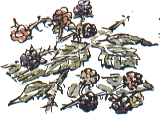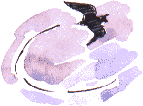Nature Diary Rocks History Gallery Home Page
It is actually a Click Beetle, Athous haemorrhoidalis, a beetle of hedges and grassland. Its young feed on roots. The click is made when it rights itself with a neat summersault, after being stuck on its back. A peg and groove on the wing cases and thorax engage with quite a loud click, a bit like someone flicking a piece of card.
When I was an art student, the bramble had a special meaning for me. I invariably sketched it when I got out of London for the long summer vacation and back to this hard-bitten patch of countryside. The bramble briar sums up this time of year. It's tough, fruitful and looks as if it was designed by William Morris. The bramble, the prickly bush, was used in folk song as a symbol of an unwise romantic entanglement. Carl Davis uses the folk song Bushes and Briars to spine-tingling effect in the score for the film Far from the Madding Crowd. Like a street cafe, stay here long enough and you'll see most of the locals drop by; butterflies, bees, birds and small mammals. Even the fox likes to eat blackberries.
|
 A BROWN BEETLE crawls across the studio floor. As our neighbour has recently discovered woodworm in a floor joist, I take a closer look.
A BROWN BEETLE crawls across the studio floor. As our neighbour has recently discovered woodworm in a floor joist, I take a closer look.

 Charolais are grazing contentedly on the valley-slope pasture, while on the rushy field, recently cut for hay, two horses, one of them pied like a Gypsy horse, grazing amongst the rushes, bring a touch of the Camargue to the valley.
Charolais are grazing contentedly on the valley-slope pasture, while on the rushy field, recently cut for hay, two horses, one of them pied like a Gypsy horse, grazing amongst the rushes, bring a touch of the Camargue to the valley.